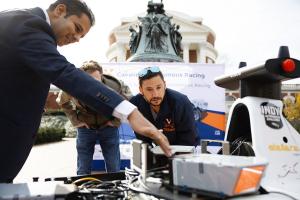
Have a need for speed? Professor Madhur Behl has you covered.
A Glimpse of Innovation at the Rotunda
UVA Engineering's Cavalier Autonomous Racing Team introduced its self-driving race car to some new fans on November 20, including UVA President James E. Ryan. Though usually speeding around racetracks or garaged in Indiana, the race car has been in Charlottesville this fall for student experiential learning and educational appearances.
Behl and his students displayed the full-scale, fully autonomous Indy race car on the North Plaza of the Rotunda. An intrigued crowd, including President Ryan, UVA students, Charlottesville residents and local media, were able to get a glimpse of the car, which has raced on tracks such as the Indianapolis Motor Speedway, home to the Indy 500.
Global Racing Pursuits
The racing team, one of only nine collegiate teams in the world to race in the Indy Autonomous Challenge, is slated to race at the Las Vegas Motor Speedway in January and on the historic Formula One racetrack in Monza, Italy in June.
Merging Speed with Knowledge
Behl, an associate professor of computer science and systems and information engineering, and director of the autonomous racing team, believes that the race car, which can reach speeds exceeding 150 mph, embodies the research, technological achievements and hard work of the racing team's talented students. Students get hands-on experiential learning by working in sub-teams focused on topics such as perception, planning, control, software integration and visualization.
"It's more than a race car," Behl said. "It's a testament to problem solving, engineering rigor and the relentless pursuit of excellence."
Beyond Velocity: The Impact on AI and Robotics
But work in autonomous racing is not just about speed — it's also about safety. Lessons learned contribute to new automotive technologies, including the broader field of artificial intelligence and robotics, helping enhance the safety and reliability of AI systems in real-world applications.
"Racing is the perfect proving ground for AI technology. If we can demonstrate racing safely at high speeds and with close proximity to other vehicles, this will have a significant bearing on the safety of passenger autonomous vehicles, which are currently facing several challenges in dealing with unusual situations,” said Behl.
CRASH: A Pioneering Research Initiative
Behl’s commitment to safety recently garnered an $800,000 research grant from the National Science Foundation’s Safe-Learning Enabled Systems program for his work called CRASH (Challenging Reinforcement-learning based Adversarial scenarios for Safety Hardening). The goal of this work is to deliberately subject an autonomous vehicle to traffic situations causing it to fail, effectively stress testing its AI software and creating what Behl calls “a crash course in how not to crash.”
“We can create realistic, plausible and rare traffic situations that subject the autonomous vehicle to unknowns, and then we can iteratively improve testing for safety,” said Behl. “Whether it is race cars or passenger autonomous vehicles, everything we do in the lab is directed toward helping us safely navigate our roads.”